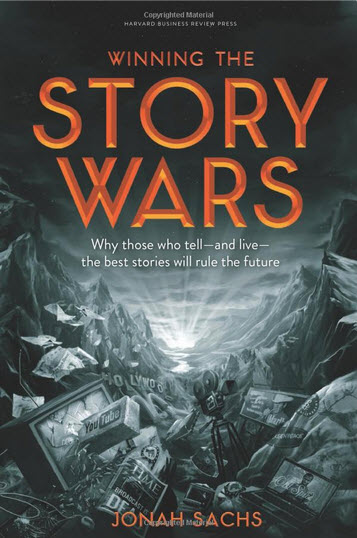 Yesterday I posted Part 1 of my interview with Jonah Sachs, author of Winning the Story Wars by Those Who Tell – and Live – the Best Stories Will Rule the Future. Below is the transcript from the second half of that interview. We pick up with Jonah discussing how nonprofits can play the role of mentor in a story.
Yesterday I posted Part 1 of my interview with Jonah Sachs, author of Winning the Story Wars by Those Who Tell – and Live – the Best Stories Will Rule the Future. Below is the transcript from the second half of that interview. We pick up with Jonah discussing how nonprofits can play the role of mentor in a story.
You can also listen to the whole interview now- it’s a little over 20 minutes long. Just push the play button.
[haiku url=”https://s3.amazonaws.com/2012npmktgdwebinars/20121008interview_jonah.mp3″ title=”Interview with Jonah Sachs”]Jonah Sachs: In all the best stories we see a kind of common pattern in the great myths of the past. Joseph Campbell identified the Hero’s Journey, which is the pattern on which Star Wars was based, Wizard of Oz, the story of Moses. They have a very common pattern which is you have this outsider, this powerless person who is not really able to – who sees the world as broken and is not really able to live out their core higher values. But they’re figuring they better to sort of muddle through, because it is better not to make waves.
Then they meet the mentor, someone like Obi-Wan Kenobi or the fairy godmother or in the case of Moses, God, who says “Actually you can have a much more purposeful life, you can fix this broken world, you have to go on this dangerous adventure, and if you do, I will help show you the way, but it is ultimately your adventure to take.” And that mentor gives them a magic gift, something like a light saber or a staff or ruby red slippers, and sends them off into this world, and this magic gift makes that impossible journey seem magically possible.
Then the hero goes into the magic world, fights some kind of problem or bad guy, comes back with the treasure, but the treasure does not make them rich — it allows them to heal society. The great stories of all time are great stories about rising to create social change, which I think is very exciting for nonprofits.
It is important for the brands to understand that if they’re not going to be the hero of the stories, they really have to find a place in the story and that is how the nonprofit can play that role of mentor. That person who calls their audience to a higher purpose, who fortifies their belief in themselves, who makes the journey seem possible.
There are a couple of ways to do this — I talk about archetypes a lot. The mentor is not that dispassionate, disconnected voice who just comes from the sky and orders the hero to go on the journey. The mentor always has to create a very human, personal connection with the hero before that journey will be taken. Nonprofits need to figure out how to embody a character, a real person that the audience can relate to. How can you create a brand voice that feels like a human being than an organization, and how can you issue your advice and your ideas in a way that feels like it is coming from another person. I use the idea of archetypes to do that.
Kivi Leroux Miller: Right, I noticed that and I think that is a great hook for nonprofits to start with. I think if they are confused by this, this is actually the best place for them to start. For example, you were talking about this magical gift and one of the archetypes is the magician. You list Make a Wish Foundation as sort of a real obvious nonprofit example there. Tell us a little bit more about the magician.
Jonah Sachs: So if you choose a brand character and you choose a magician, the magician is a brand character that we all know about who comes and, through some sort of totally different way of seeing the world, bursts of optimism and sort of belief in the magical, can make new and better things happen. And so Make a Wish Foundation is a great example of somehow finding a magical way for kids who, maybe there is a loss of hope in their life. Outside audiences might see their lives as a hopeless situation, and injecting this feeling and this experience of magic into lives that really need it. And then also injecting the magic into the lives of the donors who are a part of making these wishes really come true.
A magician brand comes along and has some kind of magic gift, in this case this model of the one amazing gift for terminally ill children that makes so much more seem possible. Obviously, they have been able to raise millions and millions of dollars over the years based on the simple idea that here is a new theory of change that feels approachable and doable, and we might be able to heal this world a little bit more through this piece of magic.
Kivi Leroux Miller: A couple of other archetypes . . .the rebel: fearless, uncompromising, creative. I see a lot of advocacy organizations using the rebel as their guide. What do you think?
Jonah Sachs: Yeah, there certainly can be. And people instantly recognize a rebel brand when they see it. In the for-profit world, Harley Davidson is the most well known. They built this whole feeling of being a part of this brand, is to express your own rebellious side. I think it is a very powerful brand, and it does require something of the organizations that choose to embody it. You can’t sort of be a half-rebel or a concessionary rebel, you really have to go and tear down something you think is not working. You name a problem and be uncompromising in how you go after it, and give people the tools to tear that problem down.
There is a caution which is, the rebel is not just about kind of destroying things for the sake of destroying them. The best rebels go and destroy with a clear vision based on love of what something better can be. The rebel brand has sort of an edge and a feeling of danger in it, but it is important also that it has a vision for something better that it can go out there with.
Kivi Leroux Miller: You also have the pioneer. Tell us a little about that kind of archetype.
Jonah Sachs: There is something a little bit similar between the pioneer and the magician in that they are trying to kind of create breakthrough solutions. The pioneer does it by really focusing on innovation, really focusing on where others have not gone before and pushing out on the edges, and experimenting and trying many things in a rapid way. It comes with charting entirely new territory.
When people see that there are these brands that are doing that, that are standing for innovation, they get excited. They think perhaps something more than what was possible in the past will be possible if they become a part of this team.
The slight problem with the pioneer of course is people feel that pioneering brands are all about the new and don’t really stick around long enough or make good partners to build the long-term value that is so necessary in the world. I think there is an opportunity for instance the pioneers of microfinance. A lot of times we see microfinance brands as pioneers. We need to watch out for the shadow side of the pioneer, as well as all archetype,s and make sure people understand we’re not just about innovation, but we’re about building long-term value as well.
Kivi Leroux Miller: The final one here is the jester. I would love to hear how you think nonprofits can embody the jester.
Jonah Sachs: Sure. The jester is, we’re all familiar with the idea of a jester, someone who makes jokes. In myths and stories, the jester is really doing that as a way of letting us look at the world in ways we might have found too painful or difficult. We do it through humor and suddenly we can start to understand the world far better.
I have had huge experience with using the jester approach to very serious issues when I made the nonprofit film The Meatrix back in 2003. Where everybody else who was talking about factory farming at the time were showing pictures of horror and animal abuse and filth and things no one would want to look at about their food, we went out and made a really funny, silly, fun movie about animals who were in a band of rebels who were fighting back against the factory farming machine.
What was amazing about it was by using this sort of humorous but very authentic and fact based approach, we were able to reach about 25 million people on an issue that no one else really wanted to talk about because we made it safe to look, and then to get angry and then get involved.
I think jester brands have a great opportunity to both step out of what is expected in the general noise of the center of what most non-profiting is about. It feels too familiar and tired, and step into something exciting and new. Of course, the problems of the world are really serious and the problems most of us try to work on are very serious, so making light of everything doesn’t work in the same way you can with a lighthearted consumer brand. But, I think there are huge opportunities to use these tools to be a breath of fresh air in nonprofit marketing.
Kivi Leroux Miller: Yeah and I believe we also saw talking cannoli in the Grocery Store Wars, right?
Jonah Sachs: Yeah, we did have a talking cannoli.
Kivi Leroux Miller: And that was about a serious issue of pesticides in food.
Jonah Sachs: That is true. We have 15 archetypes in all and this month, Free Range started selling the decks of 15 type archetypes cards and instructions on how brands can use them. If anyone is interested they can go to freerange.com and see more about these archetypes.
Kivi Leroux Miller: Okay, great, that could be really fun for a staff meeting. So what else should nonprofits know about winning the story wars?
Jonah Sachs: I think it’s really important to stay focused on audiences’ higher values. It is so easy for us to imitate what we have seen and what we have grown up with in terms of dominating marketing forms of the past. I think it is important that we don’t just imitate what we saw in the broadcast era which was kind of inadequacy marketing approach where we make audiences feel small or bad about themselves or insecure and then give them an out through brands, and even well meaning brands do a lot of that.
We need to think about really reorienting ourselves so our audiences become the hero of the story and then we need to figure out how do we embody what we’re talking about in ways that work on the human scale? What is it really like to touch and feel the work that we do? How are we really impacting individual lives and what does that feel like and look like on the ground?
Also, as I said before in terms of turning our entire brand experience into an unfolding story, one of the core things all stories have is a moral of the story, a core truth that everything that happens in the story helps to illustrate. I think the first step for every brand is to help to figure out what is that one thing about how the world works that we stand for that both will resonate here with our audience, but also will extend their understanding of how things work because they want to stand with that core truth. Once you have that, it really helps you create a consistency. These days we can’t just create one 30-second spot and that is our marketing. Our marketing is going to unfold across Facebook posts and tweets and audience generated content and our own work, you know, publishing on blogs daily. If we can’t bring the entire organization around that one core truth that we stand for, that we’re always trying to promote in the world, people will not understand what our story truly is about. I think that’s a huge opportunity.
And finally I say that stories are based on value. They are containers for values so we need to understand in an organization, what values are really stepping out and sharing with our audiences. And when we do understand what values we’re trying to create a connection on, again we can start creating far better, tangible, real life stories. But, we also have to live those values out because those things should become a focusing agent in our own organization. If we stand for justice in an organization and that is what our stories are going to talk about, we need to figure out how we can best stand for justice internally as well and how our operations, when we make choices, are about justice internally. There is so much opportunity to create better organizations when we understand that our marketing stories are value based and make our own organization value based as well.
Kivi Leroux Miller: You do talk about that kind of authenticity in the book a lot and people not living up to the values they’re espousing through their storytelling. We’ll leave that for people to learn more about through some really good examples in the book itself.
Jonah Sachs: Okay, great.
Kivi Leroux Miller: Thank you so much, I appreciate your time today.
Jonah Sachs: Thank you, it’s been great talking to you.
Kivi Leroux Miller: Check out Winning the Story Wars available on Amazon and lots of other places online. Do you have a favorite bookseller?
Jonah Sachs: I love my local bookseller but otherwise Better World Books is a great place to get books with a little more social purpose.
Kivi Leroux Miller: Thanks Jonah.
Jonah Sachs: Thank you.
For more nonprofit storytelling tips, join me October 24th for a free presentation of my popular webinar Three Stories Every Nonprofit Should Be Telling.






